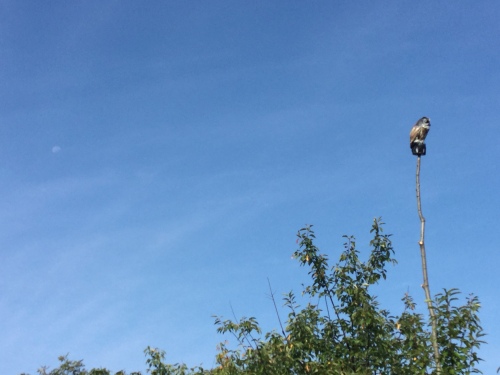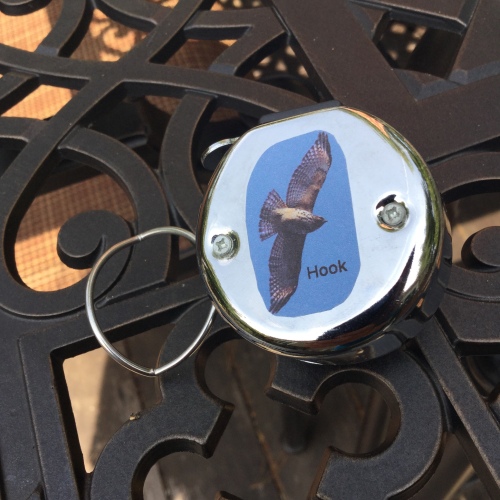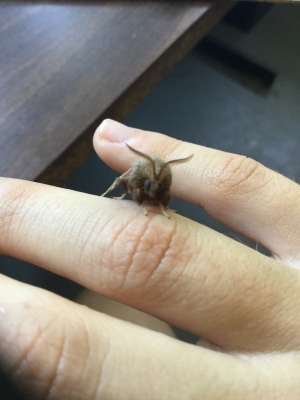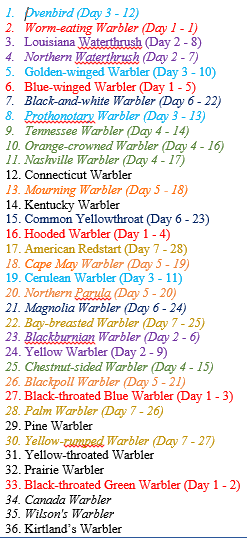
View of the Hudson. You can see the new bridge in front of the Tappan Zee, both now in use. © S.G. Hansen
Over the weekend, at my friend Anne Swaim’s notification, I connected with Trudy Battaly about standing in as the official counter on September 11 at Hook Mountain.
I have previously written about my Saw Mill River Audubon trips to Hook. This was my fourth year up there altogether, my first as a counter. Trudy, who compiles the data daily, told me I would be the only one for the day. I worried. Not only had I never officially counted before, but I am generally inexperienced with hawkwatching. How many birds would I overlook since I only have one pair of eyes for the 360° vista? How many ID battles of Sharpie vs. Cooper’s and Red-tailed vs. Red-shouldered would I face? Also, I don’t own a spotting scope. I was sure I would miss so many birds that my 10x bins couldn’t possibly catch.
Counters normally do a big sit at the top from 8-4. In the past, I have only stayed up there for 2-3 hours. I figured I could only last from 9-3, and that indeed was my time-frame for the days.
I saw my first hawks for the day – a pair of Red-tails – circling over the Executive Golf Course parking lot. The morning was sunny, cool, and windy; and the ascent quiet. I only heard a half-dozen Blue Jays, a crow, a goldfinch, and flicker.
Someone with a scope already sitting at the top. He introduced himself as Vince. He’d been coming up to Hook for years. A Rockland County local. I felt more at ease, happy to have help with the counting. Lucky me – he almost didn’t come up. Once he had read the previous day’s reports for Hook and other hawkwatches, and since he had already eaten breakfast, he made his decision. We rolled our eyes at how terrible last year’s hawk migration was.
Vince told me about the warbler fallout here the day before, and that they departed all at once just before nightfall. That explained the mountainside’s empty silence. (Thus my unfortunate streak of missing warblers this year continued…) Before I arrived, he had an Osprey, a couple of Broad-wings, and a Merlin. Slow overall. Thus began my counting. The owl prop I erected was also ready.

Thar she stands. © S.G. Hansen
As time progressed, the day warmed up to the low 70s. The NNW wind slowed from 7 to 4 knots at the most. And the haze bordering the horizon gradually increased, especially towards the southeast. Our quiet morning continued with a couple more Ospreys, our first kestrel and sharpies, and up to 15 Broad-wings.
Carl, another Hook Mountain regular, joined us at around 10. Lastly, Tom arrived at 11 (if you know any famous birders named Tom, then you’ve already filled in the last name). Now with three scopes and three additional pairs of eyes to help me watch the skies, I was ecstatic.
I want to get the Broad-wings out of the way. The day before – the 10th – observed 100 migrating. We counted 839. I was shocked to see so many. My past trips didn’t have numbers like that. 839 isn’t extraordinary for Hook (more than two thousand in one day have been observed), but Vince remarked how this movement was rare for early September. “This is what Hook Mountain is all about, Sarah,” he said several times. He, Carl, and Tom were impressed, stunned even. We gawked at our panoramic view of constant, copious Broad-wing observations. A slight breeze on a warm day turned out to do wonders. Broad-wing activity picked up mid-morning just in time for Tom, but the crème de la crème activity occurred in the early afternoon. 12-1 got 354. 1-2 got 253. Kettle after kettle. Stream after stream. (When I’d make a move to take a bite out of my sandwich one of my companions would get on more Broad-wings. Wonders how I was even able to eat lunch.) Their flight was low enough for us to see them with the naked eye. In fact, some kettles were so low that we missed them from the north and only managed to catch them once they’d moved southeast. The kettles, so ephemeral, dispersed only after a few minutes of having fully formed, and afterward the Broad-wings gently streamed over our heads, reformed kettles far to the south, or evanesced entirely.
For one of our earlier kettles, after a short lull, I announced, “There’s a bunch over the Hudson.”
Vince put his bins on it. “WOooooooooaaaAAAHhhhh. That’s a bunch, alright.”
I put my bins on the kettle again. I thought I’d seen a dozen. Turned out there was double that. “Wooooaaaah.” Triple that. The patch of sky was littered with circling winged dots. “WOOOOAAAAAHHHH.”
I didn’t count how many times Tom, eyeing the south with his scope, exclaimed, “Uh oh. Uh oh.”
“UH OHHH,” Vince would responded with exaggerated sarcasm.
After finalizing his decision to come up this morning, Vince hesitated whether or not he’d need his clicker. And he did bring it in the end. I’d have had such a difficult time tallying the Broad-wings if otherwise. I didn’t find one in the boxes that held the owl and the recording sheets. At his recommendation, I counted by the hour and rolled the clicker back to zero at hour’s beginning. While Vince, Carl, and Tom looked through their bins and scopes and declared numbers, I simply clicked away. At an earlier point, while I took down 62 Broad-wings, Tom uttered, “Ahhh, I love that sound.” Several times we’d get on a kettle, more and more Broad-wings would join from the bottom, prompting Vince to tell me to tack on four or twelve or twenty more at a time. Clickclickclickclickclickclickclickclickclickclickclickclickclickclickclickclickclickclick.
Carl had to take off shortly after 1 for an appointment, very reluctant to miss further Broad-wing action. He witnessed part of the bulk of it, but starting at 2, the movement died off as quickly as it started. I counted 60 – mostly individuals or groups of fewer than ten passing by. I didn’t miss anything spectacular after I left at 3. Vince, who stayed until 4 with Tom, counted just 1 Broad-wing.
We observed a good amount other raptor activity as well. We got two instances of owl prop action, both in the morning. Three American Kestrels, including one gorgeous male, dove at it lightning quick. A while later, two Sharpies stooped for an assault at once. They unhinged their legs like airplanes ready for landing, but they didn’t unball their talons.
At another point, we heard an unfamiliar call from the south. I thought it was a jay making funny noises. We soon learned it was Peregrine was calling. We watched an immature Peregrine fly over us, pursued by an adult, who, it turned out, was the one calling. We concluded that the adult, a resident, was chasing the migrant immature away from her territory. After that, we saw her a few more times near the Hudson. She appeared displeased that other raptors traveled through her air space.
I was annoyed that I missed the Merlin that only Vince saw. I needed it for the year, and I’d only seen one Merlin previously ever. Finally, though, between 1 and 2, I finally got my Merlin – two in fact, one right after the other. They soared near the owl.
Turkey Vulture, Black Vulture, and Red-tailed Hawk movements were low, as it is still quite early in the season. Truthfully, I screwed up their numbers; Trudy emailed me later saying that I took down too many. I should have considered the residents that fly close to the mountain multiple times, but I thought I was fine without asking for validation.
Our count of Sharp-shinned Hawks – some flew by themselves, some joined the Broad-wing kettles – totaled 42. We observed just two Cooper’s Hawks, one of which I didn’t get on. According to Vince, if there’s a large movement of Sharpies, there’s bound to be more Cooper’s. We counted nine Bald Eagle, a result of three per hour during the hours of 11, 12, and 2. The Ospreys were the most difficult to tally. It was hard to tell which were resident versus migrant, but Vince eventually went with increasing the numbers later in the afternoon when he saw them with the Broad-wings. As for Northern Harrier, only the one, a female.
Passerine movement was slow, with exception to a couple species. We observed a regular movement of over 150 Chimney Swifts throughout the day. Dozens of Barn Swallows flycatched around nine o’clock and disappeared before the hour’s end. 11 Ruby-throated Hummingbird individuals whizzed to the southeast. A Black-and-white Warbler zoomed to the north. A yellowish, greenish warbler – probably a Yellow – zipped over our heads too quickly for us to ID it with certainty. I watched Pileated Woodpecker cross from one side of the mountain to the other as it maniacally cackled. A Blue-gray Gnatcatcher silently foraged among the trees. I heard a couple jays, a chickadee, and a goldfinch. A raven croaked consistently.
Vince and Tom become butterfly enthusiasts when the birds become boring, so we enjoyed buggy movement as well. During the Broad-wing lulls, Tom briefly departed to search for butterflies. We observed 11 Monarchs migrating. After I took an extended break from counting in the middle of the afternoon, Tom guided me to a spot where he’d seen a Hackberry Emperor earlier. We saw two of those plus a Dun Skipper – both new butterflies for me. Later, a Cloudless Sulphur – a small, bright, lime green butterfly – passed through us so quickly that it took Tom and Vince by surprise.
My descent down the Mountain was a little quieter only because the jays didn’t vocalize as much. I also heard a Red-bellied Woodpecker and a White-breasted Nuthatch. Unexpectedly, I flushed an Ovenbird from the path, not even a foot in front of me. Buffy crown ruffled, keeping its eye on me, it jerked to and fro and around.
You can find Trudy’s compilation here, and the official HawkCount compilation here.
A huge thank you to Vince, Carl, and Tom for their presence. If it weren’t for them, I would not have reported the numbers I turned in and I would have grossly undercounted. I was happy to share such a spectacular hawkwatching day with them.

A present. © S.G. Hansen












